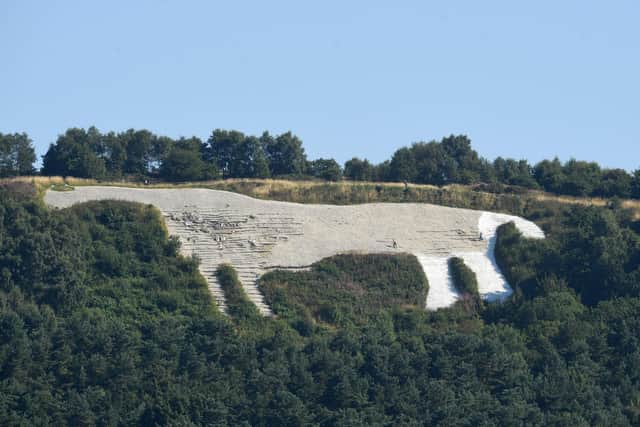White Horse of Kilburn: Historic England decline to list iconic Yorkshire hill figure due to 'unnecessary complications for little benefit' - but nearby Iron Age fort Roulston Scar has boundaries amended
The heritage body has published a report which states that giving the 19th-century hill figure in North Yorkshire protected status would cause ‘unnecessary complications for little benefit’.
However, as part of the review process, Historic England decided to amend the boundaries of nearby Iron Age hill fort Roulston Scar to reflect new information that has come to light about the ancient site.
Advertisement
Hide AdAdvertisement
Hide AdA row about the White Horse broke out last summer, when it was repainted at landowner Forestry England’s expense following complaints that its condition had deteriorated after maintenance was delayed due to the Covid pandemic.


The chalk horse, which was first etched into the landscape of Sutton Bank’s southern slope in 1857, had not had a new lick of paint since 2018, following the disbanding of the volunteers of the Kilburn White Horse Association who previously took on the task until health and safety concerns prevented further involvement. Andrew Suter, of Ampleforth, subsequently applied to the government for the figure to be listed as a Scheduled Ancient Monument in the hope of improving the maintenance requirements.
Roulston Scar – part of which is used as a landing field by the Yorkshire Gliding Glub – has been a Scheduled Ancient Monument since 1997, but an archaeological survey in 2001 revealed new boundaries.
The Historic England report reads: “As the hill figure physically cuts into the already scheduled Roulston Scar Promontory Fort, an amendment to the fort's scheduling would be necessary if the horse was also found to merit scheduling.
Advertisement
Hide AdAdvertisement
Hide Ad“The national importance of the fort is undisputed. However, during the preparation of the consultation report as part of this assessment consideration of the 2001 survey indicated that the current scheduling of the fort required slight amendment to more accurately cover the extent of the monument, including small extensions mainly on the north and west sides, with two areas of reduction to the south-west and south-east where the scheduled area had been defined too generously in 1997.
"Opportunity should also be taken to update the current description of the monument to align with the modern format and include new information from the survey report, most significantly the identification of the two burial mounds in the south-eastern part of the monument.”
Regarding the White Horse, the report considered that although some similar examples elsewhere in the UK are listed, others which are older than Kilburn’s are not.
It stated: “The Kilburn White Horse is notable for its considerable size and the extensive area of the countryside across which it can be viewed; thus ensuring its regional landmark status. It may still be identified as potentially being of national importance, but this does not necessarily mean that it should be included on the Schedule.
Advertisement
Hide AdAdvertisement
Hide Ad"Although a maintenance cycle could be managed via an agreement with scheduled monument consent, in this case it is considered that including the Kilburn White Horse on the Schedule would add unnecessary complication with little practical benefit. It is thus recommended that, on the understanding that the White Horse is in the care of
a public body that recognises its significance and the continuing need for maintenance, it is not added to the Schedule at this time.”
